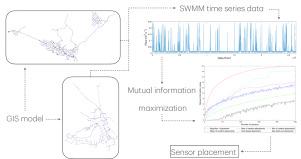当前位置:
X-MOL 学术
›
Water Res.
›
论文详情
Our official English website, www.x-mol.net, welcomes your
feedback! (Note: you will need to create a separate account there.)
Information-theoretic sensor placement for large sewer networks
Water Research ( IF 11.4 ) Pub Date : 2024-11-04 , DOI: 10.1016/j.watres.2024.122718 George Crowley, Simon Tait, George Panoutsos, Vanessa Speight, Iñaki Esnaola
Water Research ( IF 11.4 ) Pub Date : 2024-11-04 , DOI: 10.1016/j.watres.2024.122718 George Crowley, Simon Tait, George Panoutsos, Vanessa Speight, Iñaki Esnaola

|
Utility operators face a challenging task in managing wastewater networks to proactively enhance network monitoring. To address this issue, this paper develops a framework for optimized placing of sensors in sewer networks with the aim of maximizing the information obtained about the state of the network. To that end, mutual information is proposed as a measure of the evidence acquired about the state of the network by the placed sensors. The problem formulation leverages a stochastic description of the network states to analytically characterize the mutual information in the system and pose the sensor placement problem. To circumvent the combinatorial problem that arises in the placement configurations, we propose a new algorithm coined the one-step modified greedy algorithm, which employs the greedy heuristic for all possible initial sensor placements. This algorithm enables further exploration of solutions outside the initial greedy solution within a computationally tractable time. The algorithm is applied to two real sewer networks, the first is a sewer network in the South of England with 479 nodes and 567 links, and the second is the sewer network in Bellinge, a village in Denmark that contains 1020 nodes and 1015 links. Sensor placements from the modified greedy algorithm are validated by comparing their performance in estimating unmonitored locations against other heuristic placements using linear and neural network models. Results show the one-step modified greedy placements outperform others in most cases and tend to cluster sensors for efficiently monitoring parts of the network. The proposed framework and modified greedy algorithm provide wastewater utility operators with a sensor placement method that enables them to design the data acquisition and monitoring infrastructure for large networks.
中文翻译:

大型下水道网络的信息论传感器放置
公用事业运营商在管理污水管网以主动增强管网监控方面面临着一项艰巨的任务。为了解决这个问题,本文开发了一个框架,用于优化下水道网络中传感器的放置,目的是最大限度地获得有关网络状态的信息。为此,提出了互信息作为通过放置的传感器获得的有关网络状态的证据的量度。问题表述利用网络状态的随机描述来分析系统中的互信息,并提出传感器放置问题。为了规避放置配置中出现的组合问题,我们提出了一种新算法,称为一步修改的贪婪算法,该算法对所有可能的初始传感器放置采用贪婪启发式算法。该算法允许在计算可处理的时间内进一步探索初始贪婪解之外的解决方案。该算法应用于两个真实的下水道网络,第一个是英格兰南部的下水道网络,有 479 个节点和 567 个链接,第二个是丹麦村庄 Bellinge 的下水道网络,包含 1020 个节点和 1015 个链接。通过使用线性和神经网络模型将来自修改后的贪婪算法的传感器放置与估计未监控位置的其他启发式放置的性能进行比较来验证。结果表明,在大多数情况下,一步修改的贪婪放置优于其他放置,并且倾向于将传感器聚集起来以有效地监控网络的某些部分。 提出的框架和改进的贪婪算法为污水公用事业运营商提供了一种传感器放置方法,使他们能够为大型网络设计数据采集和监控基础设施。
更新日期:2024-11-04
中文翻译:

大型下水道网络的信息论传感器放置
公用事业运营商在管理污水管网以主动增强管网监控方面面临着一项艰巨的任务。为了解决这个问题,本文开发了一个框架,用于优化下水道网络中传感器的放置,目的是最大限度地获得有关网络状态的信息。为此,提出了互信息作为通过放置的传感器获得的有关网络状态的证据的量度。问题表述利用网络状态的随机描述来分析系统中的互信息,并提出传感器放置问题。为了规避放置配置中出现的组合问题,我们提出了一种新算法,称为一步修改的贪婪算法,该算法对所有可能的初始传感器放置采用贪婪启发式算法。该算法允许在计算可处理的时间内进一步探索初始贪婪解之外的解决方案。该算法应用于两个真实的下水道网络,第一个是英格兰南部的下水道网络,有 479 个节点和 567 个链接,第二个是丹麦村庄 Bellinge 的下水道网络,包含 1020 个节点和 1015 个链接。通过使用线性和神经网络模型将来自修改后的贪婪算法的传感器放置与估计未监控位置的其他启发式放置的性能进行比较来验证。结果表明,在大多数情况下,一步修改的贪婪放置优于其他放置,并且倾向于将传感器聚集起来以有效地监控网络的某些部分。 提出的框架和改进的贪婪算法为污水公用事业运营商提供了一种传感器放置方法,使他们能够为大型网络设计数据采集和监控基础设施。


















































 京公网安备 11010802027423号
京公网安备 11010802027423号